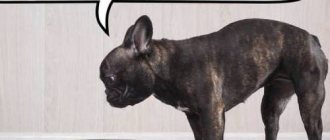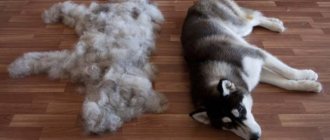You are calmly walking your dog on a leash when suddenly he refuses to move forward. She decided that her ass would remain tied to the ground until she wanted to move again! All dog owners have already had to deal with this situation, sometimes funny and sometimes awkward. When faced with this, we don't always know how to react because we are afraid of upsetting our dog or hurting it. Don't worry, these few tips will teach you how to behave when your dog refuses to go for a walk!
Something terrible happened
Dogs remember negative experiences well and try to avoid repetition. Remember, perhaps something unpleasant happened on your last walk: the pet was frightened by a sharp sound, another dog, a neighbor who sharply slammed the door in his face. If the puppy has not yet been socialized, anything can be a deterrent. Also, if a dog cuts its paw while walking, it may associate the street with a source of danger.
There is no need to try to drag a frightened and whining pet out the door by any means. Try to defuse the situation. For example, first put on the collar casually to try it on. Let your pet run around the house wearing a collar. Then fasten the leash, then get dressed, but don’t go out right away. Open the door, evaluate the pet's reaction. Close it, and after a while, go out with the dog on a leash. If she resists, lure her with a treat in your fist or a toy. Try not to put pressure on the dog, speak in a calm, gentle voice and show that it is safe behind the door. If something really happened on the street, try to avoid this place in the future until the pet forgets about the trouble. If necessary, consult a zoopsychologist.
Causes of fear
The fundamental reason for this seemingly unnatural phobia is the extremely low level of socialization of the puppy. Most often, fear of the street is observed either in dogs that have lived in shelters for a long time and have never left the enclosure, or in puppies that breeders kept in cages or in very confined spaces.
Any living creature is characterized by an instinctive fear of everything unfamiliar. For a dog, with its heightened sense of hearing, touch and smell, a sudden change of environment associated with the transition from a small space to a huge world filled with smells and sounds is a great stress. To help your pet overcome this fear, you need to understand the root causes of his phobia.
The most common reasons for not walking:
- Fear of the dark. It may be due to either a shock experienced or a certain visual defect.
- The puppy has never left the apartment before
- Fear of loud sounds from other people and animals. In other words - lack of socialization.
- Fear of strangers. It may be due to abuse or beatings from the puppy's previous owners.
- Photophobia. Sometimes this indicates the presence of a serious pathology.
- Fear of certain breeds of dogs. It can develop after they attack a puppy.
- Adverse weather conditions. For example, a short-haired puppy gets very cold during rain or frosty weather.
- Individual experiences. The puppy could be greatly frightened by an exploding firecracker, or the sharp sound of a car alarm going off nearby; in the puppy’s memory, experiences associated with the period of homeless existence, etc. come to life.
Unsuitable weather
Just like people, pets do not like to go outside in bad weather. Moreover, not only memories of the previous wet and cold walk can affect, but also the mood of the owner. If you try to take a walk as quickly as possible in bad weather or even stand near the entrance, waiting for the dog to do its business, do not be surprised that at some point the pet will refuse to go out in the rain and will remain at the entrance door.
One of two things: either you walk as you should, even in bad weather, follow your usual route, or you stay at home and go for a walk when it clears up. Take care of your dog's clothes: perhaps your pet is just cold. In the rain, by the way, you can have fun at home, for example, create an obstacle course from improvised objects or play tug of war.
Arthritis and other musculoskeletal diseases
Joint inflammation is a common ailment in dogs, especially in older dogs. The following symptoms are observed with arthritis:
- The dog tries to move less.
- Weight gain occurs due to decreased activity.
- The pet is reluctant to walk on stairs.
- There is lameness, whining and other signs of discomfort when the dog gets up after sleeping.
Dysplasia of the elbow and hip joints. The problem is that most dogs are prone to dysplasia from birth. Symptoms:
- It is difficult for the dog to get up after sleep.
- Until the pet moves away, he has a wobbly gait. With hip dysplasia, a rabbit gait may be observed.
- If left untreated, the condition slowly but steadily worsens.
- At the slightest weight gain, the dog begins to avoid any activity.
- It is difficult for a pet to jump, maneuver while running, or walk up stairs.
The main problem with dysplasia is that it cannot be treated.
It's boring to walk
Active dogs that love to run and explore may stop loving walking if they walk the same route every day exclusively on paths. Even if they don’t refuse to leave the house, getting ready for a walk is perceived without much enthusiasm and willingly turns back.
In this case, it is imperative to diversify street activity. Dogs that do not fully satisfy their hunting instincts can become depressed, get sick, and change their behavior beyond recognition (become uncontrollable and irritable). Try to take a new route each time. Play outdoor games with your pet even in winter.
Seasonal allergies
Almost all owners are well aware of the dangers of food allergies, but the dog's body can react sharply to dust, pollen and other bloom products. If your dog is allergic, during the flowering season of the grass he may feel ill when walking. You may not notice this visually, but allergy symptoms will make themselves felt:
- Swelling of the mucous membranes.
- Non-localized itching.
- Decreased appetite.
- Copious discharge from the eyes and nose.
- Cough, shortness of breath and other breathing problems.
- Skin irritation, even urticaria.
- Rarely and only in severe forms of allergies - nausea, vomiting, diarrhea.
Inconvenient equipment
It happens that the muzzle presses, the collar rubs, the clothes press, and therefore the pet does not want to go for a walk, since for him every step promises discomfort or pain. Most often, hostility to equipment is accompanied by growling and refusal to put on ammunition.
Calluses and sore spots on your pet’s body will help you figure out what exactly you don’t like. If there is nothing, try loosening the collar, discard the muzzle, unfasten the raincoat and watch your pet’s reaction. In the future, purchase more comfortable equipment.
Disease
Domestic dogs are completely dependent on the daily routine and pace of life of the owner. Thanks to the ability to adapt, within a short period of time, the dog’s body begins to work at a “comfortable” pace for it. It is thanks to this feature that adult pets tolerate going to the toilet and do not feel acute hunger between feedings.
Most owners whose dogs suddenly refuse to go for walks immediately suspect illness. There is some truth in these suspicions, especially if the dog has suddenly become apathetic.
The first thing to do if the dog refuses to go for a walk is:
- Superficial inspection - we check the condition of the fur, skin, paws, claws, eyes, ears, mouth.
- We examine the mucous membranes.
- We check the temperature of the mucous membranes and body.
- We monitor your appetite and drinking regime.
- We palpate the joints and abdominal area of the dog.
Feels bad
In this case, you will have to carefully observe your pet to understand what is hurting him. Some small breeds, for example, pugs, French, English bulldogs, due to the peculiarities of the spine, cannot go up and down stairs on their own. Walking begins to be associated with back pain, and therefore the desire to go out the door disappears. It is better to carry such babies in your arms or ride them in an elevator.
The pet may feel unwell due to infection, problems with the digestive system, or joint pain. Usually, malaise is accompanied by other signs - loss of appetite, apathy, vomiting. Refusal to go out for a walk may be a symptom of a false pregnancy. If you suspect your pet is not feeling well, consult your veterinarian.
Be sure to find out the reason for your reluctance to go out and try to correct the situation. Don't force your dog outside: this will only make the problem worse. Lure him with treats, toys, affectionate words, and commands. To overcome your fear of the street, first walk in the entrance, then nearby and in the yard. Don't forget about training and positive reinforcement.
Photo source:
Socialize your puppy outdoors
When you move your training session outside, remember that being outdoors can be a stressful event for your puppy.
All the sights, sounds and smells can be overwhelming. Proper socialization will help combat your puppy's anxiety and build confidence.
Introduce your puppy to people of all shapes, sizes and nationalities. Don't forget about all the ways humans can be different from dogs, such as glasses, wheelchairs, and hats.
You should also expose your puppy to a variety of different dogs and environments. However, you should not force these meetings. Let your puppy initiate contact and move at his own pace.
Maintain a positive attitude and combine new outdoor experiences with games, praise, and treats.
This will help your dog become accustomed to the world and see other people and dogs as friends rather than threats.
Psychological
Fear
Dogs can be afraid of walking for various reasons, for example:
- low socialization of the dog caused by too early separation from its mother or life in a shelter: a puppy, and sometimes an adult dog, is afraid of the outside world and hides behind its owner at the first opportunity;
- stress during one of the previous walks: the dog was scared and does not want to repeat the negative experience (a car honked loudly, there was a clap of thunder, fireworks flashed brightly, there was a conflict with another dog - there may be plenty of reasons);
- change of place of residence - even moving out of town can be the reason for the dog’s reluctance to leave the house and go out to where everything is so unfamiliar, and there is nothing to say about changing the place of walks from a quiet park in a residential area to a busy boulevard in the city center.
There is no need to scold or feel sorry for a frightened dog, especially if we are talking about a puppy. A calm, friendly attitude and encouragement at every part of the path traveled in the form of praise or treats will help the pet regain self-confidence and calmly leave the house. If your attempts are unsuccessful, seek advice from a competent animal psychologist.
Common Mistakes
Walking puppies that are too young and have not undergone the first vaccination can lead to infection and even death if they come into contact with other dogs. Such babies can only be walked in your arms.
Attempts to calm a puppy showing signs of panic (plaintive whining, tucking its tail, trying to retreat into the bushes, trembling all over the body). Soothing stroking and coaxing will be perceived by the puppy as praise for this behavior. To prevent a repetition of the situation, you need to fraudulently lead your pet to the object that frightened it and convince it of its safety. If the puppy obeys and behaves calmly, you should praise him and give him a treat.











